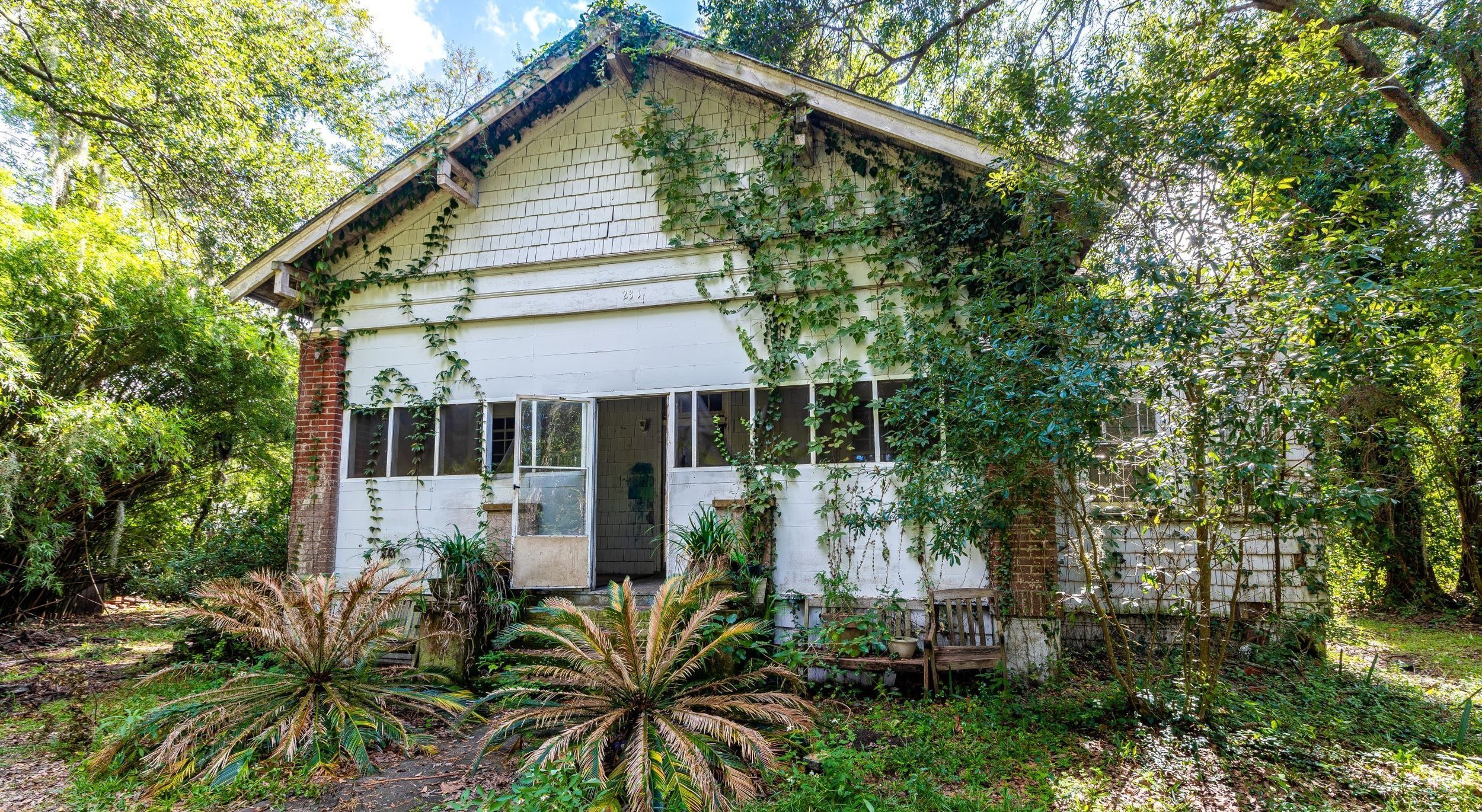COMPLETED September 2022
Streetcar Cottage
Above: The Streetcar Cottage was a home built of- and around- two historic streetcars. It was discovered, abandoned and overgrown, when the property was purchased by a new owner in 2022.
History of the Streetcar Cottage
The Streetcar Cottage at 11 Waite Drive in Savannah, GA, was a very unique structure. Two historic retired Briney Safety Streetcars, repurposed as additions, flanked a wood framed structure located on Isle of Hope. Built prior to 1957, Wilkie and Evelyn Browne were likely the first residents in the Streetcar Cottage. After sitting vacant for a number of years, in 2022 the current owner engaged Re:Purpose Savannah to deconstruct the wood frame structure while preserving the streetcars. The owner then donated both streetcars to the Isle of Hope Historical Society for future restoration.
The wooden structure was clad in clapboard siding that extended past the two streetcars on the front elevation. One streetcar had access from the exterior through a small wooden gable extension with a doorway that was added to the original steel streetcar body. The roof was a compilation of separately built roof structures with an overarching gabled roof built on top spanning the wooden structure and both streetcars. One-over-one double hung wooden sash windows with awning screens were present on the wooden structure. Original one-over-one double hung wooden sashes of different variations exist on the streetcars, although some were later replaced with one-over-one aluminum windows. The front of each streetcar also contains two single lite fixed wooden sashes of different sizes and a one-over-one fixed wooden sash. The interior of the wooden structure displayed beadboard over the walls and ceiling and the interior of the streetcars still contain the original wooden paneling on the ceiling.
Chain of Title
*Land was known as the Wilkes Farm Tract. Between 1910 and 1900, the Wilkes (Wilks) family owned farm land addressed “Grimball Point.”
Unknown - 1956 The McIntyre Family
The McIntyre Family started to subdivide their land and eventually sold a parcel of land to the Browne Family in 1956. This parcel later became 11 Waite Drive.
1956 - 2022 The Browne Family
1958 Wilkie C. & Evelyn H. Browne; George Edwin Browne, Son. Shown living at “Grimble Point, Isle of Hope.”
Wilkie C. Browne was previously married to Anna Lawton Barnes Browne and had two children, Elizabeth Ann and Wilkie C. Browne III (died at 14.) In 1952, Wilkie C. Browne was recently divorced and working for Atlantic insurance and Investment Co., (also known as Atlantic Mutual Fire Insurance Co.) as the Vice President Secretary. Wilkie married Evelyn O. Huggins that year. Evelyn had recently been widowed and moved from Florence, South Carolina to Savannah. She worked as a bookkeeper for a radio station during this time.
1986 First appearance of “11 Waite Drive” in the City Directories.
C.A. Porter
1993 - 1997 “11a” Daniel W. Shook
“11a” O.J. Wooten
1998 - 2022 George E. (Passed in 2012) & Terry Z. Browne II
2009 - 2022 Elizabeth Ann Browne
2012 Deeded to George Edwin Browne II
2013 Deeded to Terry Z. Browne
2017 - 2020 Rachel E. Outman (Backus)
2022 Ann Daiss - Present
Re:Purpose Savannah was hired to deconstruct the Streetcar Cottage and the Streetcars were donated to the Isle of Hope Historical Society for future restoration. Additionally, the ranch house was demolished.
Isle of Hope Streetcar Line
On December 20, 1866, the Savannah City Railway Company (renamed Savannah-Skidaway and Seaboard Railroad Company, SS & S in 1869) was granted a twenty-year charter by the Georgia State Legislature to build a railroad that would allow direct travel by streetcar for residents to and from downtown Savannah, Isle of Hope, Skidaway Island, Thunderbolt, Montgomery Cross Road, and White Bluff. The Isle of Hope streetcar line was completed and opened for use in March of 1870. The streetcars first used were steam powered, which were soon replaced by horse drawn streetcars to decrease costs. By 1890, electric streetcars began to replace the use of horse drawn ones. The Savannah Electric Company was eventually formed in 1901 from the merging of the City and Suburban Railway Company, the Savannah, Thunderbolt, and Isle of Hope Railway Company, and the Edison Electric Illuminating Company of Savannah; and in 1921 the Savannah Electric and Power Company was formed from the merging of the Savannah Electric Company and the Savannah Power Company. Ultimately, gasoline powered automobiles caused the demise of the electric streetcar and on August 26, 1946, the last running electric streetcar made its last trip from Savannah to Thunderbolt.
Birney Safety Streetcar
The Birney Safety Streetcar was a popular brand of streetcars that gained prominence in the 1920s. Charles O. Birney and Joseph M. Bosenbury created the design of the Birney Safety Streetcar and patented it in 1915. Owned by J.G. Brill Company, the American Car Company was the official builder for the brand, though additional companies started to produce Birney Safety Streetcars shortly thereafter. Birney Safety Streetcars were popular among interurban street lines due to the increased capacity, single car setup, and dual motors. In the same year as the merge, the Savannah Electric and Power Company purchased 30 Safety Birney Streetcars.
History
Many thanks to Ethos Preservation for providing thorough research of the Streetcar Cottage!
Click the image below to learn more about this building’s history:
What is your relationship to the Streetcar Cottage?
Do you have insight into the history of the Cottage? Have you made something out of the materials we reclaimed from the Cottage? We would love to collect your histories and re-use stories to share in our growing archive!





















































